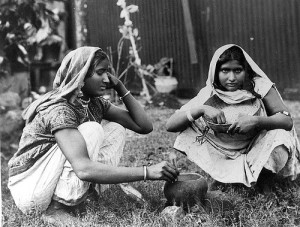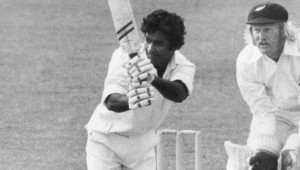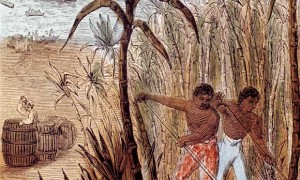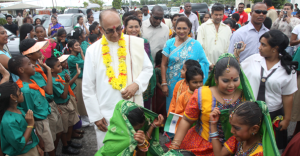The Indo-Windies connection in cricket
Denesh Ramdin, captain of West Indian Cricket team
By Kersi Meher-Homji
As you watched the recent Australia -West Indies Test series in the Caribbean on television in June, were you struck by the names of some of the Windies cricketers?
The team was captained by Denesh Ramdin who also kept the wickets, the opening batsman was Rajendra Chandrika and the spinners were Devendra Bishoo who took 6 for 80 in the first Test in Roseau, Dominica and Veerasammy Perumaul.
Spinner Devendra Bishoo
Till a few years ago Shivnarine Chanderpaul (almost 41 years old now) was their leading batsman and captain. Also Sunil Narine is in their Test team as an off-spinner.
These are all Indian names as although born in the West Indies they have Indian ancestry. Most of them look like Indians as well.
Coincidentally, they are batsmen, spinners or wicket-keepers. Not a fast bowler among them ”“ a typical Indian characteristic!
Alvin Kallicharan
Even in the past the West Indies team had celebrated cricketers of Indian origin, spinner Sonny Ramadhin shining in Test cricket from1950 to 1960, Rohan Kanhai (who was as good with the bat as Garry Sobers) from 1957 to 1973 and Alvin Kallicharan from 1971 to 1980. They could be described as legendary cricketers.
Other Windies Test players of Indian origin are Ramnaresh Sarwan, Ravi Rampaul, Inshan Ali, Nyron Asgarali, Faoud Bacchus, Leonard Baichan, Daren Ganga, Narsingh Deonarine, Imtiaz Ali, Raphick Jumadeen, Dave Mohammed, Ivan Madray, Rajindra Dhanraj, Sewnarine Chattergoon, Mahendra Nagamootoo, Dave Mohammed, Charran Singh, Rangy Nanan, Charran Singh, Suruj Ragoonath, Ryan Ramdass, Dinanath Ramnarine and Sewdatt Shivnarine.
I did some research in cricket reference books and Google on the migration of Indians to the West Indies. And this is what I found.
Migration from India to Guyana

Indian women cooking
On 5 May 1838, the year of finalised abolition slave emancipation in the British West Indies and thus began the indentured labour system, 396 Indian immigrants popularly known as the ‘Gladstone Coolies’ landed in British Guiana (now Guyana) from Calcutta.
Indian coolie woman brought to Caribbean as part of indentured labour system
This was the beginning of the indenture system which was to continue for over 75 years and whose essential features were very reminiscent of slavery. Within a decade Indian immigration was largely responsible for changing the fortunes of the sugar industry, the mainstay of the economy, from the predicted ”˜ruin’ to prosperity.
The importation of labour from the Indian subcontinent was part of a continuing search by Guianese planters for a labour force that was docile, reliable and amenable to discipline under harsh, tropical conditions. Emancipation was conferred on the Guianese labourers both physical and occupational mobility.
The majority of Indian immigrants were drawn from North India with smaller batches coming from the Tamil and Telugu districts of South India. They were recruited, very often on spurious promises, by professional recruiters, largely assisted by paid local agents called “Arkatis” in North India and “Maistris” in South India.
Indian indentured labourers working in sugar fields
This system of recruitment by local agents formed the backbone of all recruiting operations from the inception of the system to its cessation in 1917. Intimidation, coercion and deception were very often used to recruit Indian labourers. Women in particular were very vulnerable. When labourers were difficult to enlist, the recruiters resorted to such illegal practices as kidnapping and forced detention. Many recruited to be shipped off the Caribbean were falsely advised on where they were heading.
Names of places would be altered, to fit a higher meaning. For example, recruiters told migrants, heading to Dutch Suriname they were heading to Sri-Ram, instead of Suriname, taking into account that Ram in the Hindu religion means a religious place where good triumphs over evil.
With a need for labour, after the slave emancipation within British territory in 1834, the recruited Indian immigrants set sail for Guiana and other British West Indian territories. Upon arrival, the newly transplanted indentured servants (slaves?) were forced to adapt to extreme tropical conditions, along with their new working contract conditions.
From1835 to1918, over 341,000 indentured labourers from India were imported into British Guiana. Treatment of the newly arrived immigrants was horrendous, pushing them into isolated communities.
They were required to sign a contract, the terms bounding their service to a plantation for five years, while earning a fixed daily wage. Once this five-year period had passed they would have another five years of industrial residence in Guiana. Then they were entitled to free repatriation. At the end of the contract laborers either returned to India or stayed in British Guiana. Those who stayed received land and money to start their own businesses.
Unlike the African slaves, the East Indian indentured workers were permitted to retain some of their cultural traditions. But the process of assimilation made the culture of the modern Indo-Guyanese more homogeneous than that of their caste-conscious ancestors.
Between 1838 and 1917 over 500 ship voyages with 238,909 indentured Indian immigrants came to Guyana; while 75,898 of them or their children returned to India. The vast majority of the Indian immigrants came from the Hindi speaking areas of North India.
The most popular Hindustani dialect spoken among them was Bhojpuri (spoken in east Uttar Pradesh and west Bihar), followed by Awadhi (spoken in central Uttar Pradesh). Over 60% of the Indian immigrants to Guyana came from districts that are now part of the Indian state of Uttar Pradesh, 21% from districts that are now part of Bihar state, 6% were from pre-partioned Bengal, 3% from what are today Orissa and Jharkhand states, 3% from what is today Tamil Nadu state, 3% from Central India, 1% from pre-partitioned Punjab and the remaining 1% from the rest of India. Interestingly, 96.8% of all the Indian immigrants to Guyana left from the port of Calcutta and 3.2% from the port of Madras.
The religious breakdown of the Indian immigrants to Guyana was 85% Hindus and 15% Muslims.
Festivals and Holidays
Indian Arrival Day is an important holiday in many Caribbean nations that commemorates the arrival of immigrants from the Indian subcontinent in the 19th century. In Guyana, the holiday takes place on May 5, the day Indian labourers landed there in 1838. Almost half of Guyana’s population are descendants of these immigrants.
Guyanese Hindus continue to observe holidays such as Holi and Diwali while Muslims celebrate Eid and Kurbani (Bakreid – sacrifice of the sheep). In Guyana, the Indian arrival day is celebrated on May 5 commemorating the first arrival of indentured servants from India to the country.
Weddings
Among Hindus and Muslims, arranged, comparatively early marriages were common until the early 1960s but are rare now. Middle-class Indians had greater freedom in choosing a spouse, especially if the woman was a professional. As in most parts of the western world marriage now occurs later and the family unit is smaller. Indian families are patriarchal and often function as corporate economic units.
For individuals who are Hindu, weddings are performed with the bride and groom dressed in traditional Indian clothing. If it can be afforded there is usually a
wedding ceremony and also a western or “regular” wedding reception, or a small Hindu ceremony and a much larger “reception” so friends from the larger community can attend.
Food
With the blending of cultures in the West Indies Indo-Caribbean dishes became one of the dominant notes throughout most of the English Caribbean, with dishes such as curry and roti and daal puri. Dishes that survived the colonial period include gulab jam, kheer and chicken curry, generally served at weddings, poojas, and religious functions.
And of course they took to cricket, excelling in batting and spin bowling like their ancestors in India. In all 32 of the 297 West Indies Test cricketers have Indian origin, a high percentage of 10.77.
Short URL: https://indiandownunder.com.au/?p=5113






